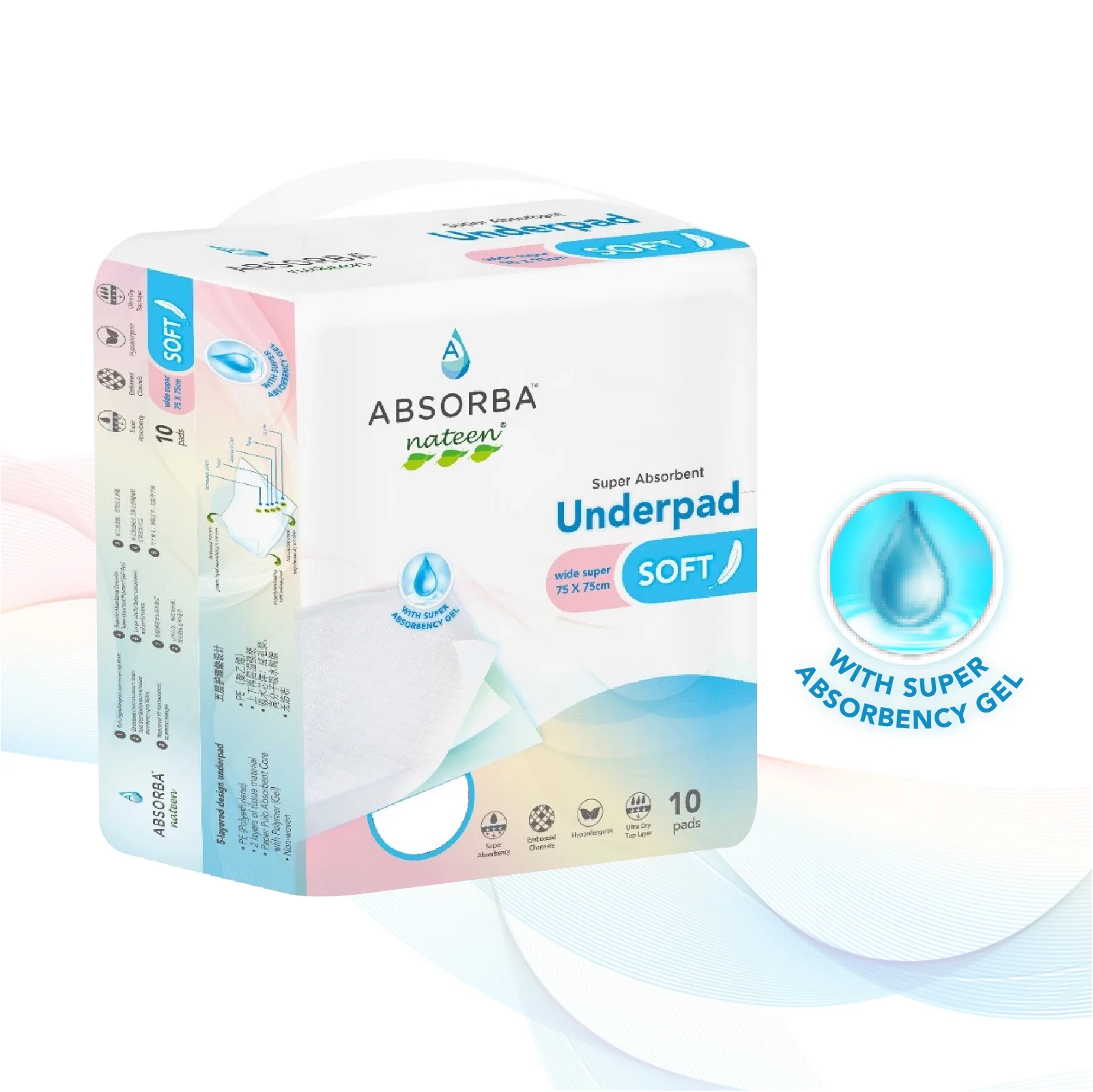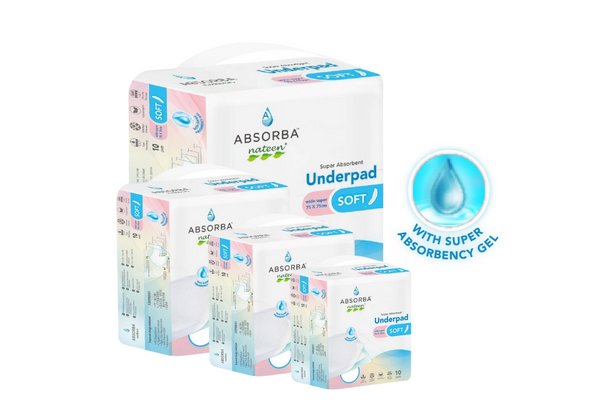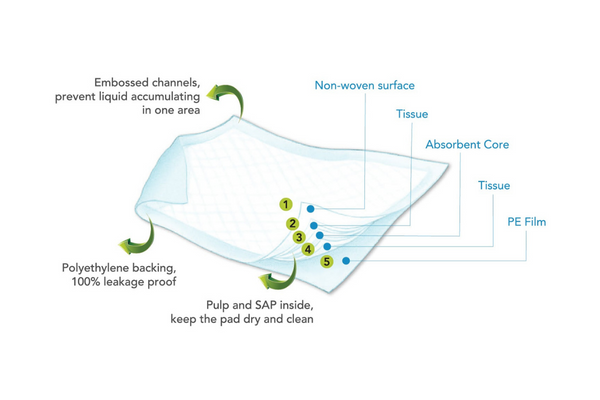
Once incontinence is identified, a patient may experience anxiety and embarrassment. There is a sizable population of people who believe they won’t be able to carry out everyday tasks any longer. Due to the lack of flexibility in the abdominal area and pelvic area, older persons should use underpads to avoid leakage.
While underpads are essential for the aged, they are quite helpful for individuals who experience a few mishaps or need defense against bedwetting.

Many people are concerned that incontinence may prevent them from leaving their home. Incontinence underpads play a crucial role in managing bladder leakage. But what exactly are incontinence underpads and how can they help you? Let’s explore the options used by Singaporeans.
What are adult incontinence underpads?
Disposable underpads, often known as Chux, are very absorbent pads that shield the bed from bladder contamination. As per preference, you should normally position the pad directly beneath the sheets.
They perform a critical function in catching the seeping fluids. You may use them on a big scale in assisted living institutions and clinics to protect the upholstery and bedding from urine stains.
Who uses these incontinence underpads?
A diverse group of people who experience bladder or bowel control issues use adult incontinence underpads. While many people may associate incontinence with the elderly, it can affect individuals of all ages and backgrounds.
Expectant mothers may experience temporary incontinence during pregnancy. This is due to the pressure on their bladder as the baby grows. Adult incontinence underpads can provide a reliable and convenient solution in these cases. They protect against leaks and accidents, providing comfort and peace of mind.
Adults who suffer from chronic incontinence may also benefit from using these underpads. The pads are ultra-absorbent because it could handle large amounts of liquid quickly. Additionally, it minimize the risk of exposure to urine or feces. They are useful for individuals with mobility issues or bedridden. Also, it prevents skin irritation and infection.
2 types of incontinence underpads
-
Disposable underpads
As its name implies, disposable incontinence underpads are to be used once only. They come in numerous types and dimensions and contain a waterproof plastic substance at the bottom, a middle layer suited for containing leakages, and a top surface composed of smooth, absorbent, and comfy fabric.
People who use these disposable underpads will generally feel quite comfortable since the first layer, which is in contact with the skin, is comprised of components such as cotton. The tissue ingredients in these underpads also facilitate mobility without the worry of ripping the pad.
-
Reusable underpads
Reusable underpads consist of elements such as absorption, textures, and thickness. The absorbency of the underpad is determined by its ability to retain liquid. To create the absorbent coating, a polymer that can absorb liquids is needed. The amount of fluids the underpad can retain and its fluid retention capacity are determined by the quality of the polymer and two other criteria.
How to use the incontinence underpads?
Refer to the following advice if you’re unsure how to use a disposable underpad:
Cut the wrapper using scissors from the bottom side of the packing
You must cut the item bag apart using scissors from the underside of the box in order to use the disposable underpad. To avoid tearing through the entire package, you must cut into the sides of the bag’s bottom portion until the scissor looks to be tightly gripped.
Besides this, lift the bottom from both edges and keep opening either side of the package till the packing is open. Set the underpad down on the bed surface, and retrieve a disposable adult diaper for changing.
-
Unraveling the pad
In this situation, you must grasp the product’s edge and then fling it forth. This will generate an airburst for the parting of the underpad. The white side of the product retains water whilst the plastic-looking side performs a significant part in discouraging moisture. In case you notice that both surfaces are white, go for the one with a non-glossy and flat texture. Ensure that the patient is lying on the side without plastic.
How often should the underpads be changed?
Disposable bed pads should be changed often, especially after getting dirty. To prevent harming the layer of the skin, you might need to replace the underpad more regularly depending on the extent of the leakage. A good approximation is as described in the following:
- For light incontinence, use 1 to 2 underpads daily.
- As for mild incontinence, use 2 to 4 underpads daily.
- Lastly heavy incontinence, use 4 to 6 underpads daily.
Advice on how to keep the mattress dry
Buy mattress covers that are waterproof
Waterproof mattress covers are a wonderful investment, particularly for trying to keep your mattress fresh, and function as mattress covers that are normally put under the bed linen.
There are several variations available, such as mattress protectors with zippers, flat mattress covers that are secured with elastic hooks on each side, and mattress toppings with tailored skirts that are elasticized.
Buy ultra-absorbent incontinence pads

The use of extremely absorbent incontinence pads is especially important for nursing homes, homes for the elderly, and home care. These environments require a high level of hygiene and sanitation to prevent the spread of infection and disease. Ultra-absorbent pads can help maintain a clean and safe environment by reducing the risk of contamination from urine or feces.
In conclusion, buying ultra-absorbent incontinence pads or liners is a wise decision for anyone suffering from incontinence. These products can help you effectively manage your condition, prevent leaks and accidents, and maintain good hygiene and sanitation. Whether you live at home or in a care facility, ultra-absorbent pads can simplify your life and make you feel more comfortable and secure.
Prevent incontinence-related skin conditions
The proper incontinence supplies can protect you or your family members from skin conditions that could cause irritation. Regularly replacing dirty underpads can prevent future bacterial infections related to dampness and poor hygiene. Wipes, lotions, and other incontinence items including adult diapers, sanitary napkins, and bowel control pads could further collect bladder leakage.
Conclusion

When choosing the right type of incontinence protection product, you should always look at what your needs are. As long as it is made out of breathable materials and can hold up against sweat and urine, then it should be fine. Don’t forget to make sure that you protect yourself from incontinence!
If you are searching for the best diapers in Singapore, please contact us for any enquiries regarding our adult underpad or incontinence products.
